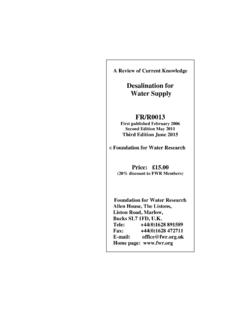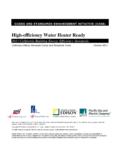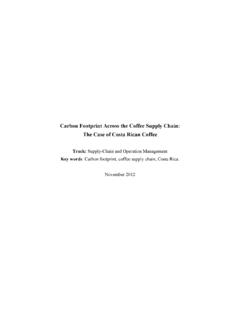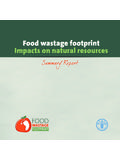Transcription of WATER CONSERVATION REPORT - Welcome to NYC.gov
1 INTRODUCTION 1 Bill de BlasioMayorVincent Sapienza, CommissionerWATER CONSERVATION REPORTJune 2017 Annual UpdateNon-Residential WATER Efficiency ProgramSTRATEGY 5 WATER supply Shortage ManagementSTRATEGY 4 WATER Distribution System Optimization141618 STRATEGY 1 STRATEGY 2 Residential WATER Efficiency ProgramMunicipal WATER Efficiency ProgramTAblE Of CONTENTS612 INTRODUCTION4 STRATEGY 3 STRATEGY 6 Wholesale Customers demand Management2022 WATER demand TRACKING4 INTRODUCTIONDEP values the role of WATER CONSERVATION and demand management in the responsible long-term management of New york city s WATER supply .
2 As a result, WATER demand is down more than 30% since the 1990s, despite consis-tent increases in population (Figure 1). With predictions of warmer temperatures and greater variability in precipitation due to climate change, however, DEP must consider this increasing uncertainty in the management of the city s WATER supply and the corresponding demand . Further, the leaking Delaware Aqueduct and its planned shutdown and repair in 2022 as part of DEP s WATER for the Future Program is a known, near-term event that creates an imperative to proac-tively manage and explicitly reduce existing WATER demand to ensure adequate WATER supply through this s WATER demand Management Program is in its fifth full year of implementation.
3 DEP continues to make progress with reducing WATER demand through establishing partner-ships and completing multiyear projects that will continue to reduce WATER consumption in the date, DEP completed numerous WATER challenges with non-residential customers, launched the Toilet Replacement Program, began drafting demand management plans with wholesale customers, and retrofitted more than 400 build-ings and 32,000 fixtures throughout the ,0001,1001,2001,3001,4001,5001,600196019 7019801990200020102020 Population in MillionsWater demand (MGD)Calendar Year NYC demand (MGD)New york city PopulationAverage Daily demand (MGD)2010:1,0392011: 1,0212012:1,0092013: 1,0062014:9962015: 1,0092016: 1,002 Figure 1: Timeline showing historical WATER demand and New york city population growth.
4 The six most recent years are Croton DamINTRODUCTION INTRODUCTION 550 Miles 75 Miles 100 Miles 125 Miles West BranchReservoirNew CrotonReservoirKensico ReservoirNeversinkReservoirPepactonReser voirAshokanReservoirSchoharieReservoirRo ndoutReservoirCannonsvilleReservoirEast BranchReservoirBog BrookReservoirBoyds CornerReservoirLakeGleneidaMuscootReserv oirMiddleBranchReservoirTiticusReservoir DivertingReservoirCroton FallsReservoirAmawalkReservoirCross RiverReservoirKirk LakeLakeGileadHillviewReservoirJerome ParkReservoirNeversinkTunnel1954 WATER Tunnel 1917 Richmond Tunnel 1970 WATER Tunnel 1996 Delaware Aqueduct 1940sCatskill Aqueduct 1917 West Delaware Tunnel 1964 East Delaware Tunnel 1955 Shandaken Tunnel 1927 CrotonAqueduct1893 CatskillAqueductDelaware Aqueduct Silver Lake Park(underground storage tanks)Esopus CreekNew york BayLong Island SoundAtlantic OceanDelaware RiverNeversink RiverHudson River BrooklynStaten IslandBronxManhattanQueensQueensGroundwa terService AreaCroton Filtration PlantCat/Del U/V Disinfection FacilityEast Branch DelewareWest Branch DelewareCatskill/DelewareWatershedsCroto nWatershed25 Miles (from city Hall)
5 New JerseyNew YorkRockland CountyWestchester CountyConnecticutOrange CountyPutnamCountyUlsterCountyDutchessCo untySullivanCountyPennsylvaniaColumbiaCo untyGreeneCountyAlbany CountyRensselaerCountySchoharieCountyOts egoCountyChenangoCountyDelawareCountyWat er Tunnel 1936 6 MUNICIPAL WATER EFFICIENCY PROGRAMU nder the Municipal WATER Efficiency Program, DEP contin-ues to upgrade city infrastructure and reduce WATER demand . Several of the individual programmatic initiatives will reach completion by summer has made significant progress in advancing WATER efficiency projects in partnership with municipal agencies, including the Department of Parks and Recreation (DPR), Department of Education (DOE), the Fire Department of New york (FDNY), and the city University of New york (CUNY).
6 DEP has also advanced CONSERVATION projects at its waste- WATER treatment plant facilities. Currently, DEP is completing a study to identify additional municipal CONSERVATION proj-ects, partnership opportunities, and demand savings. The study will expand the Municipal WATER Efficiency Program and is expected to be completed in June will continue to advance wide-ranging efforts that incorporate WATER efficiency retrofits, education, curriculum development, metering, and WATER benchmarking to ensure permanent municipal WATER January 2017, DEP completed its third Commissioner s WATER Challenge with three participating plants: Red Hook, Tallman Island, and Rockaway.
7 Tallman Island won the challenge, with a consumption reduction of 11%, or 15,000 gallons per day. DEP staff at Tallman Island achieved their savings in a unique way, as described in the Case Study on page 2016, DEP purchased a new mechanical and pump seal system for the Port Richmond Wastewater Treatment Plant. DEP will continue to monitor this investment and the associ-ated WATER savings to evaluate if the same system could be implemented at other plants. DEP will launch its fourth Commissioner s WATER Challenge with DEP s four remaining plants in summer 2017. At the completion of the fourth challenge, a fifth challenge that will encourage all 14 plants to reduce demand by 5% will be launched in High School in Staten IslandMUNICIPAL WATER EFFICIENCY PROGRAMSTRATEGY 1 Initiative 1: Save WATER in Wastewater Treatment Facilities STRATEGY ONE 7 DEP continues to consistently track metered data and long-term trends for all 14 wastewater treatment plants, to ensure that reductions continue after WATER Challenge participation.
8 See Figure 2 for updated standard operating proecedures at DEP s wastewater treatment plants. Standard Operating Procedure on city and Effluent WATER Use1. Meters - city WATER Record WATER consumption on a weekly basis and compare to Automated Meter Readings by logging onto My DEP Account . If there are discrepancies or if the meter(s) appear to be malfunctioning, contact John Sexton, Chief, Energy Analysis & Planning Leaks city WATER Immediately isolate and repair in-house or submit Work Request to Effluent WATER Strainer System Clean strainer basket once per day. If system is malfunctioning, repair leaks in-house or submit Work Request to engineering.
9 Develop maintenance plans and schedules for effluent WATER pumps. Maintain the effluent WATER pumps in accordance with the developed plans and schedules and keep an inventory of Pump Packing Use of Mechanical Seals Mechanical seals are only to be used on MSPs and effluent WATER pumps. They are only to be used in these type pumps if the application meets all applicable manufacturer s criteria. This applies to new pump purchases and when transitioning from traditional packing to mechanical Use of Effluent WATER * instead of city WATER Use effluent WATER instead of city WATER in the applications listed below. If an application could be sensitive to the use of effluent WATER instead of city WATER , contact the Energy Analysis & Planning Section for further evaluation.
10 * For cleaning/washing, utilize effluent WATER only if there will be no human contact with the surfaces after they have been cleaned with effluent Use of city WATER Do not use city WATER to freshen up tanks. When using any type of hose for washing down areas where city WATER must be used, a low flow nozzle should be Flush WaterAeration TanksThickenersFinal TanksChlorlorine Contact TanksBlowersEnginesHeat ExchangersCentrifugesAC ChillersAC CondensersFoam ControlCooling WaterHypochloritePolymerCleaning/Washing TanksGrit WashingGrit SuspensionAgitation WaterBalance WATER (Thickeners)Flushing (Centrifuges)Blockage Removal in PipesMiscellaneousDilution/MixingCommiss ioner s WATER ChallengeDuring the development of the WATER demand Management Plan, DEP worked to identify large capital projects that would spur WATER savings at wastewater treatment plants.
















